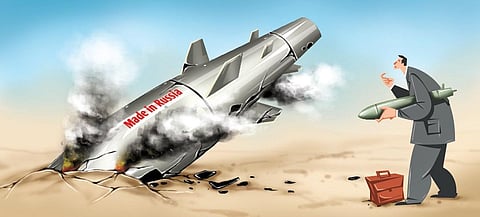

There is a marked urgency in government to boost India’s defence production, and arms exports have become key to driving those targets. About a week ago, speaking at the 12thDefense Expo in Gandhinagar, Union Defence Minister Rajnath Singh said the government had set a target of $22 billion for defence production by 2025; and since domestic demand may not provide economies of scale, a target of $5 billion in exports would provide the push.
About a month ago, Singh had pegged the same target for defence production at Rs 1.75 lakh crore for domestic requirements and Rs 35,000 crore for export markets. Quoting a Stockholm International Peace Research Institute (SIPRI) report of 2021, he said world’s military spending had crossed $2 trillion for the first time, and it was time India cashed in on the rising demand for arms world over.
Indigenisation has been a recurrent theme as part of the government’s atmanir bhart or ‘self-reliance’ campaign. In August 2020, the ministry took off 101 arms-related items from the ‘import list’ and reserved for domestic production. The ‘positive indigenisation list’ has now been expanded to 411 items.
The earlier policy relied entirely on 16 Defence Public Sector Undertakings (DPSU) and 41 government-owned ordnance factories. This has changed to welcoming private sector participation and allowing up to 74% foreign direct investment (FDI). A June 26 PIB circular says “333 private firms have been issued a 539 industrial licences. Out of these, 110 firms have reported commencement of production.”
Inaugurating the Defence Expo at Gandhinagar, Prime Minister Narendra Modi said arms exports had increased eight-fold in last five years to about Rs 13,000 crore, mostly contributed by private sector. This included the sale of BrahMos cruise missiles to the Philippines worth Rs 2,770 crore.
Dependence on imports
This self-congratulation however disguises India’s high dependence on imports. India has just replaced Saudi Arabia as the world’s largest arms importer, and each of these two countries account for 11% respectively of the global arms imports. Where exports are concerned, SIPRI says during 2017-21, India was at 23rd spot out of 25 of the largest arms exporters, accounting for a mere 0.2% share of world’s arms exports.
The urgency to diversify and indigenise production comes from the need to reduce India’s reliance on Russian defence systems, which the Ukraine war is proving to be of poor quality. Russia’s share in India’s arms imports fell from 67% in 2012-17 to 46% in 2017-21, but this has not reduced its dependence on Russian supplies.
From heavy lifting Ilyushin aircraft to MiG supersonic fighters to submarines, Indian armed forces mainly run on Russian gear. This Russian connection can’t be cut in a jiffy as deployment and training takes years to absorb. Moreover, India has committed to future imports like Russian submarines and expensive surface-to-air (SAM) S-400 Triumf system, procured in the teeth of US opposition.
Leaning on Russia for oil and weapons has put India in a difficult position on the world stage vis-a-vis Ukraine war. India is now worried it may land on the losing side. As the Ukraine war grinds on, the world is seeing the superior gear used by committed Ukrainian forces turn the tide of the war against Russia. The US light, shoulder-fired ‘Javelins’ has destroyed hundreds of Russian tanks; and Russian artillery can’t match the US Himars – the M142 High Mobility Artillery Rocket System –which fires guided missiles to pinpointed targets like ammunition dumps and strategic bridges. In precision and speed, Western technology seems strides ahead.
Lack of R&D
Besides BrahMos missile, other Indian defence gear that has evinced interest abroad include ‘Akash’ air defence platform as well as advanced light helicopters, offshore Patrol boats, and coastal surveillance systems. Better sales and marketing will enhance exports, but it is lack of new technology and precision research that is our Achilles Heel.
The Defense Research and Development Organization (DRDO) has a network of 52 laboratories, manned by 5,000 military scientists and engineers, and a support staff of about 25,000. And, despite DRDO’s galloping budget of over Rs 20,000 crore, up from Rs 13,000 crore in FY17, there is little to show.
The 16 defence PSUs collectively show export revenue of Rs 1,300 crore last fiscal. Defence commentator Ajai Shukla says the problem is: “India allocates by far the highest percentage of its defence budget on personnel costs, with a hefty 59% going on salaries and pensions.” China and the UK spend 41% and 42%, respectively, of their defence budgets on modernisation, India spares no more than 25% on equipment modernisation.
Military hardware and defence systems need constant upgrades and focused investment year after year. Former army chief General (Retd) V P Malik, speaking at a conclave in Chandigarh in 2019, said:“the armed forces are always blamed for supporting imports, but they have no other alternative.”